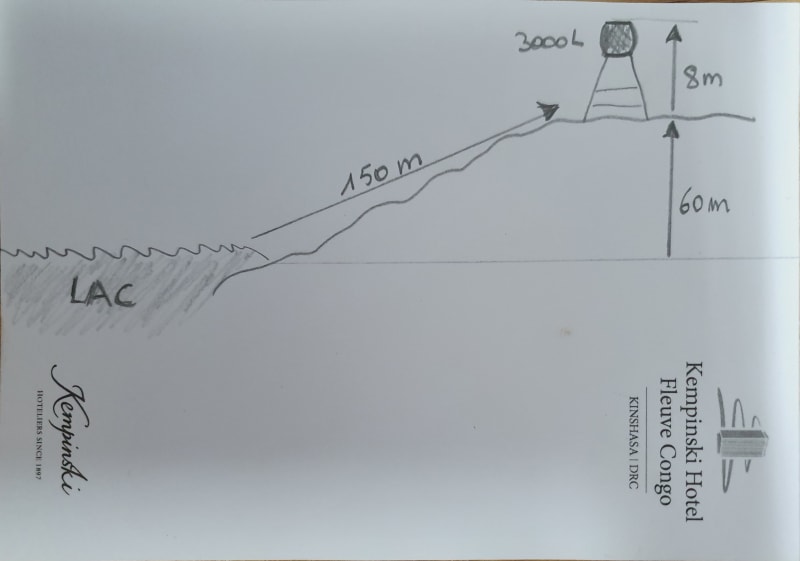You have a high head/low flow/low power situation. I'm in the USA and all my calculator programs for this type of stuff use US Customary (English) units, so I'm going to use both unit systems here to help me debug the calculations we need to do before we get to a pump. In some cases I am using a soft conversion, but the differences here are slight. If someone finds a mistake, please correct me.
Your minimum desired flow rate is 3,000 l / 240 min => 12.5 l/min (3.3 gpm). If we round up to 15 l/min (4.0 gpm), use a 50-mm pipe (2.0 in), and assume a Hazen-Williams C of 130 (probably slightly conservative), the head loss in the 150 m (492 ft) of discharge piping would be less than 0.1 m (0.3 ft). This is small enough to ignore. However, the flow velocity (0.12 m/s or 0.4 fps) is probably far too low for this situation since you are pumping raw water. I just don't know how "raw" your raw water is.
If we use a 25-mm pipe, the head loss would be 2.5 m (8.2 ft) and the flow velocity would be 0.5 m/s (1.6 fps). You might want an even smaller pipe, so as to increase the velocity, but I don't know what sizes you have available. In any event, the penalty for using a smaller pipe would be higher head losses. However, for this discussion, I will keep the pipe at 25 mm. On this basis, we can estimate a total dynamic head of about 60 m + 8 m + 2.5 m = 70.5 m (231 ft), plus a little for minor losses. Let's say the TDH with everything is 71 m (233 ft).
Assuming a pump hydraulic efficiency of 70%, the power requirement for a pump flowing at 15 l/min and generating 71 m of head is 0.25 kW (0.34 hp). IIRC, the smallest pump I have used was 0.5 hp or maybe 1 hp for a sump in a truck loading dock. I don't know what efficiency to assume on the electrical side (IIRC, most of my systems have been in the 92%-94% electrical efficiency range). Regardless, I would think that if a solar power system that generates at least 0.3 kW would be OK. I would probably target 0.4 kW or 0.5 kW just to be sure. However, since I am not an electrical engineer and I have never used solar power for this type of installation, take this part of the discussion with a grain of salt.
My first thought is some sort of submersible pump. I have seen (but not designed) two installations for pulling raw water directly out of a lake. Others on this forum will certainly have more experience with this type of project. One installation used a submersible sewage pump hung beneath a raft (see
for an example of a pump that I have used for sewer service). The other installation used a multi-stage submersible pump mounted to a raft. I didn't actually see this pump, but it was described to me as being similar to a vertical turbine booster pump or a vertical turbine well pump with a short shaft. I suspect it was something like this:
The problem with the sewage-type submersible pumps that I am familiar with (which have only one impeller) is that I don't think any exist that can pump as little as 15 l/min at a head as high as 71 m. You are more likely to find a pump that do something like 150 l/min at 10.5 m TDH.
On the other hand, there should be multistage submersible pumps that can meet these service conditions, although I didn't find a perfect match in my limited search.
If you don't go the submersible route, then the project gets more complicated, so I won't go there now.
I did find some solar powered pumps, but none that would meet these service conditions. So, I suspect you are going to have to get the pump and solar panel separately and integrate the two. Again, someone with more experience in what you are trying to do may have the perfect solution that I wasn't able to come up with. But, I hope this is still useful to you.
==========
"Is it the only lesson of history that mankind is unteachable?"
--Winston S. Churchill


